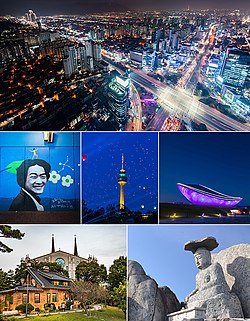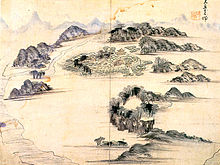A | B | C | D | E | F | G | H | CH | I | J | K | L | M | N | O | P | Q | R | S | T | U | V | W | X | Y | Z | 0 | 1 | 2 | 3 | 4 | 5 | 6 | 7 | 8 | 9
You can help expand this article with text translated from the corresponding article in Korean. (October 2023) Click for important translation instructions.
|
Daegu
대구 | |
|---|---|
| transcription(s) | |
| • Hangul | 대구광역시 |
| • Hanja | 大邱廣域市 |
| • Revised Romanization | Daegu-gwangyeoksi |
| • McCune-Reischauer | Taegu-kwangyŏksi |
 Top: Beomeo Jct, Second: a portrait in Kim Gwangseok Street in Bangcheon Market, Daegu 83 Tower, ARC cultural center in Gangjeongbo riverside area, Bottom: Daegu Jeil Church and surrounding area, Gatbawi Statue in Gwanamsa Temple | |
 | |
 | |
| Coordinates: 35°52′18″N 128°36′06″E / 35.87167°N 128.60167°E | |
| Country | South Korea |
| Region | Yeongnam |
| Districts | 7(gu) 2(gun) |
| Government | |
| • Type | Mayor–council |
| • Mayor | Hong Joon-pyo (People Power) |
| • Body | Daegu Metropolitan Council |
| Area | |
| • Total | 1,499.51 km2 (578.96 sq mi) |
| Elevation | 106 m (348 ft) |
| Population (October 2022) | |
| • Total | 2,366,852 |
| • Density | 2,730/km2 (7,100/sq mi) |
| • Dialect | Gyeongsang |
| Demonym | Daeguite |
| GDP | |
| • Total | KR₩ 63 trillion US$ 50 billion (2022) |
| Area code | +82-53 |
| ISO 3166 code | KR-27 |
| Flower | Magnolia |
| Tree | Fir |
| Bird | Eagle |
| Website | Official website (English) |
Daegu ([tɛ̝.ɡu], Korean: 대구; Hanja: 大邱; lit. large hill), formerly spelled Taegu[a] and officially known as the Daegu Metropolitan City (Korean: 대구광역시; Hanja: 大邱廣域市), is a city in southeastern South Korea.
It is the third-largest urban agglomeration in South Korea after Seoul and Busan; it is the fourth-largest metropolitan city in the nation with over 2.3 million residents; and the second-largest city after Busan in the Yeongnam region in southeastern Korean Peninsula. Daegu and surrounding North Gyeongsang Province are often referred to as Daegu-Gyeongbuk, with a total population over 5 million.
Daegu is located in south-eastern Korea about 80 km (50 mi) from the seacoast, near the Geumho River and its mainstream, Nakdong River in Gyeongsang-do. The Daegu basin is the central plain of the Yeongnam region. In ancient times, the Daegu area was part of the proto-kingdom Jinhan. Subsequently, Daegu came under the control of the Silla Kingdom, which unified the Korean Peninsula. During the Joseon dynasty period, the city was the capital of Gyeongsang-do, one of the traditional eight provinces of the country.
Daegu was an economic motor of Korea during the 1960s–1980s period and was especially known for its electronics industry. The humid subtropical climate of Daegu is ideal for producing high-quality apples, thus the nickname, "Apple City".[4] Daegu is also known as "Textile City".[5] Textiles used to be the pillar industry of the city. With the establishment of the Daegu-Gyeongbuk Free Economic Zone, Daegu is currently focusing on fostering fashion and high-tech industries.
Daegu was the host city of the 22nd World Energy Congress, the 2011 World Championships in Athletics and the 2003 Summer Universiade.[6] It also hosted four matches in the 2002 FIFA World Cup.
Historyedit
Prehistory and early historyedit
Archaeological investigations in the Greater Daegu area have revealed a large number of settlements and burials of the prehistoric Mumun pottery period (around 1500–300 BC). In fact, some of the earliest evidence of Mumun settlement in Gyeongsangdo have been excavated from Siji-dong and Seobyeon-dong.[7] Dongcheon-dong is one of the substantial Mumun agricultural villages that have been excavated.[8] The Dongcheon-dong site dates back to the Middle Mumun (around 850–550 BC) and contains the remains of many prehistoric pit-houses and agricultural fields. Megalithic burials (dolmens) have also been found in large numbers in Daegu.
Ancient historical texts indicate that during the Proto–Three Kingdoms (Mahan, Jinhan, and Byeonhan) period, Daegu was the site of a chiefdom or walled-town polity known from that time, according to historical records, as Dalgubeol. It was absorbed into the kingdom of Silla no later than the fifth century. The vestiges of the wall can be seen, and relics have been excavated in the current Dalseong Park.

Sillaedit
Silla succeeded in unifying the Korean peninsula by defeating the other kingdoms of Baekje and Goguryeo in the late seventh century, partly due to assistance from China's Tang dynasty. Shortly thereafter, in 689, Silla's King Sinmun considered moving the capital from Gyeongju to Daegu, but was unable to do so.[9] This initiative is known only through a single line in the Samguk Sagi, a most valued historical record of ancient Korea by Koryeo dynasty historian Kim Bu-sik, but it is presumed to indicate both an attempt by the Silla king to reinforce royal authority and the entrenched resistance of the Gyeongju political elites that was the likely cause of the move's failure.[10] The city was given its current name in 757.
In the late 1990s, archaeologists excavated a large-scale fortified Silla site in Dongcheon-dong, Buk-gu.[11] The site at Locality 2 consists of the remains of 39 raised-floor buildings enclosed by a formidable ditch-and-palisade system. The excavators hypothesize that the fortified site was a permanent military encampment or barracks. Archaeologists also uncovered a large Silla village dating to the sixth to seventh centuries AD at Siji-dong.[7]
Later Three Kingdoms and Goryeoedit
During the Later Three Kingdoms period, 892–936, Daegu was initially aligned with Hubaekje. In 927, northern Daegu was the site of the Battle of Gong Mountain between the forces of Goryeo under Wang Geon and those of Hubaekje under Gyeon Hwon. In this battle, the forces of Goryeo were crushed and Wang Geon himself was saved only by the heroic deed of his general Shin Sung-gyeom. However, the atrocities of the Hubaekje forces at this time apparently changed local sympathizers to favor Wang Geon, who later became the king of Goryeo.
Numerous place names and local legends in the area still bear witness to the historic battle of 927. Among these are "Ansim", which literally means "peace of mind", said to be the first place where Wang Geon dared to stop after escaping the battle, and "Banwol", or half-moon, where he is said to have stopped and admired the moon before returning to Goryeo. A statue commemorating the battle now stands in northern Daegu, as does a memorial to Sin Sunggyeom.
In the Goryeo period, the first edition of the Tripitaka Koreana was stored in Daegu, at the temple of Buinsa.[12] However, this edition was destroyed when the temple was sacked in 1254, during the Mongol invasions of Korea.[13]
Joseonedit

Daegu served as an important transportation center during the Joseon dynasty, being located in the middle of the Great Yeongnam Road which ran between Seoul and Busan, at the junction of this arterial road and the roads to Gyeongju and Jinju.
In 1601, Daegu became the administrative capital of the Gyeongsang-do, which is current Daegu, Busan, Ulsan, Gyeongsangbuk-do, and Gyeongsangnam-do. At about that time, the city began to grow into a major city. The status continued for nearly 300 years, and the city has been transformed as the capital of Gyeongsangbuk-do since Gyeongsang-do was divided into two provinces, Gyeongsangbuk-do (northern Gyeongsang-province) and Gyeongsangnam-do (southern one) in 1896.
Daegu's first regular markets were established during the late Joseon period. The most famous of these is the Yangnyeongsi herbal medicine market. This became a center of herbal trade in Joseon, and even attracted buyers from neighboring countries. Traders from Japan, who were not permitted to leave the Nakdong River valley, hired messengers to visit the market on their behalf. Seomun Market, which stood at the city's west gate at that time, was one of the top-three markets in the Joseon period.
Korean Empire and colonial ruleedit
Japanese imperialism forcibly opened up Korea's markets beginning in the late 19th century. In 1895, Daegu became the site of one of the country's first modern post offices, as a part of the 'Gab-o' reforms introduced in the aftermath of the First Sino-Japanese war.[14]
Beginning in the late 1890s, increasing numbers of foreign merchants and workers started to visit Daegu, which emerged as a modern transportation center of the newly constructed Gyeongbu Line main railroad connecting Seoul and Busan.
In 1905, the old fortress wall was forcibly destroyed. As a tribute to the wall, streets that now run where the wall once stood have been named Bukseongno, Namseongno, Dongseongno and Seoseongno, which translates as "north fortress street", "south fortress street", "east fortress street" and "west fortress street" respectively.
Independence movements against imperial aggressions were outstanding in Daegu. These began as early as 1898, when a branch of the Independence Club was opened in the town.[15] As the demise of the Korean Empire approached in 1907, local citizens led by Seo Sang-don organized the National Debt Repayment Movement. The movement spread nationwide, although it fell short of repaying the national debt through individual donations. Freedom fighting continued after the 1910 annexation, notably during the March 1st movement of 1919. At that time, four major demonstrations took place in Daegu, involving an estimated 23,000 peace-loving citizens.[16]
After 1945edit
In 1946, the Daegu October Incident took place, one of the most serious social disorders since the foundation of the Republic of Korea.[17] On October 1, Korean national police killed three student demonstrators and injured many others.[18] It was also the site of major demonstrations on February 28, 1960, prior to the presidential election of that year.[19]
Daegu and all of North Gyeongsang province had heavy guerrilla activities in the late 1940s, as thousands of refugees shied away from the fighting in Jeolla province and sought shelters in Daegu.[20] In November 1948, a unit in Daegu joined the mutiny which had begun in Yeosu the previous month.[21] As in many other areas during the Korean War, political killings of dissenters were widespread.
During the Korean War, heavy fighting occurred nearby along the Nakdong River. Daegu sat inside the Pusan Perimeter, however, so it remained in South Korean hands throughout the war. The fighting that prevented North Korean troops from crossing the Nakdong River has become known as the Battle of Taegu.
In the second half of the 20th century, the city underwent explosive growth, and the population has increased more than tenfold since the end of the Korean War. The city was politically favored during the 18-year-long rule of Park Chung Hee, when it and the surrounding area served as his political base. Daegu champions conservative political ideas and movements today and is a political base for the Saenuri Party.
In the 1980s, Daegu separated from Gyeongsangbuk-do and became a separately administered provincial-level directly governed city (Jikhalsi), and was redesignated as a metropolitan city (Gwangyeoksi) in 1995. Today, Daegu is the third-largest metropolitan area in Korea with respect to both population and commerce.
Since 1990, Daegu has suffered two of South Korea's worst mass casualty disasters: the 1995 Daegu gas explosions, which killed 101 people, and the 2003 Daegu subway fire, which killed 192 people.
In February 2020, Daegu was the epicenter of the COVID-19 pandemic in South Korea.[22]
In July 2023, the Gunwi County of the North Gyeongsang Province integrated into Daegu.
Politicsedit

Two local governments are in the city, the Daegu Metropolitan Government in Jung District and Gyeongbuk Provincial Government in Buk District. The provincial government will be relocated to Andong in its proper province, Gyeongbuk. As a result, the provincial government office was relocated to Andong in January 2023. The mayor and heads of city's eight districts are directly elected by the citizens every four years. The city council has 29 members which consist of 26 from the same number of electoral districts and three proportional representations. They are also directly elected every four years. Most of them are the members of the People Power Party, the main conservative political party in South Korea. Daegu is a stronghold for the party and has produced four Presidents of the Republic of Korea thus far: Park Chung Hee, Chun Doo-hwan, Roh Tae-woo and Park Geun-hye. Park Chung Hee and Chun Doo-hwan were born in other cities but they moved to Daegu and spent childhood in Daegu. As the capital of the Korean conservatives, the city has wielded strong political influence in elections.[citation needed]
Administrative divisionsedit

Daegu is divided into 7 districts (Gu) and 2 counties (Gun)
- Jung District (중구, 中區) – means the central district.
- Dong District (동구, 東區) – means the east district.
- Seo District (서구, 西區) – means the west district.
- Nam District (남구, 南區) – means the south district.
- Buk District (북구, 北區) – means the north district.
- Suseong District (수성구, 壽城區)
- Dalseo District (달서구, 達西區)
- Dalseong County (달성군, 達城郡)
- Gunwi County (군위군, 軍威郡)
Geographyedit
Topographyedit

Daegu sits in a basin surrounded by low mountains. Palgongsan to the north, Biseulsan to the south, Waryongsan to the west, and a series of smaller hills in the east. The Geumho River flows along the northern and eastern edges of the city, emptying in the Nakdong River west of the city.

Climateedit
| Daegu | ||||||||||||||||||||||
|---|---|---|---|---|---|---|---|---|---|---|---|---|---|---|---|---|---|---|---|---|---|---|
| Climate chart (explanation) | ||||||||||||||||||||||
|








